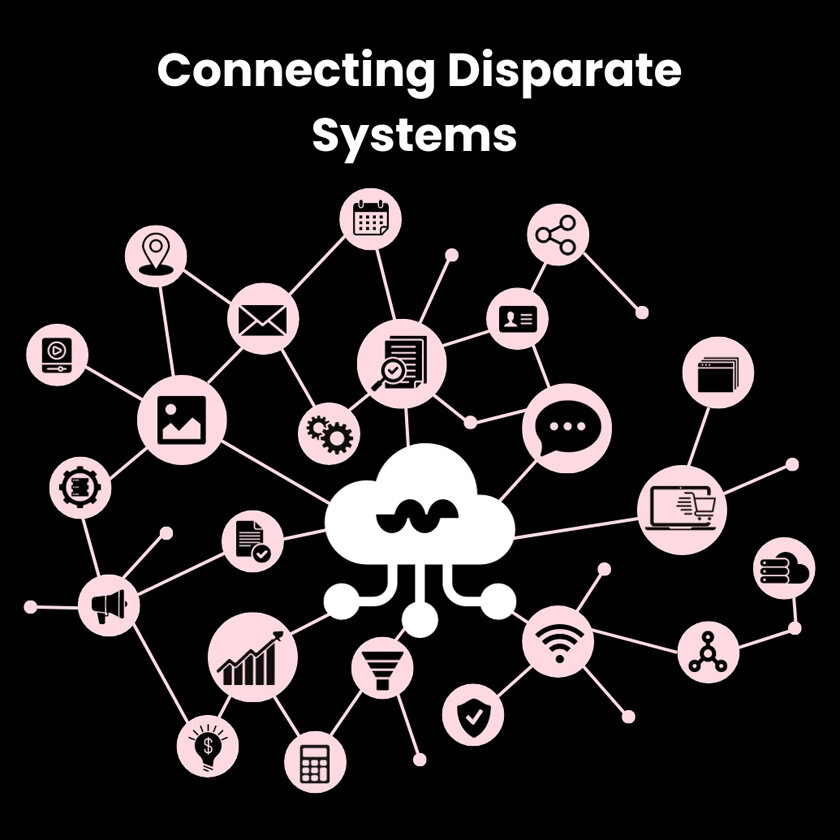As businesses continue diversifying and expanding, integrated systems will become increasingly vital in ensuring productivity, efficiency, and success.
How many discrete software apps do you use across your entire business setup? 10, 20, or maybe even 50? The numbers might seem high, but when one considers the number of tools used by the different teams in the organization, they do add up. Since data plays a critical role in driving efficiency and decision-making, data across disparate systems could result in significant challenges for organizations. Basically, disparate systems are databases or software that aren’t integrated but are separate. Integrating this tech stack and different business systems will combine all the tools essential for digitally transforming the business and offering customers a better and more efficient experience. In this article, we’ll explore disparate systems, their implications, and the key reasons businesses should integrate them.

What are disparate systems?
In the world of IT, disparate systems are computer data processing systems functioning on their own without working with other computer processing systems or sharing data. They’re also known as information silos due to how they’re isolated from other systems. Each such disparate system comprises a data processing environment layer, a layer of data, and a layer of software. Since they don’t communicate with each other, it could lead to identical data being stored on every system, making automation difficult.
Why should organizations integrate disparate systems?
- Reducing costs due to data entry errors: Efficient business operations understand that trying and preventing mistakes is much cheaper than fixing them. Moreover, they also widely acknowledge the fact that human errors are bound to occur when data is frequently moved across systems, causing seemingly insignificant errors to have substantial financial consequences. So, when businesses maintain data across platforms, it results in functioning smoothly like a coordinated machine, ensuring transparent decision-making, smooth operations, and increased productivity.
- Boosting productivity and efficiency: This is a natural follow-up to the above point. Repeatedly transferring data between systems is not only tedious but also wastes valuable resources, resulting in potentially more errors. Integrating systems not only eliminates these redundancies but also gives employees instant access to data for prompt responses. Moreover, data from integrated systems generates more accurate and faster reports, translating to better-informed business decisions.

- Real-time Reporting: Outdated and disparate systems can often limit access to information in businesses, resulting in decision-making being uncertain. Hence, real-time visibility is quite impossible to achieve in disparate systems and on-premise solutions. Integrated systems are real game changers as they provide secure, easily accessible, and reliable data to employees. So they’re better informed and can make quicker and more accurate decisions that are most useful for stakeholders. Since unified systems ensure readily available, up-to-date data, they’re a more trustworthy source of information and become the foundation for good business decisions.
- Merging IT operations and cutting costs: It might not appear outright, but the cumulative effect of software licenses, subscriptions, and other associated costs could be significant. When looked at closely, the financial costs of disparate systems could be overwhelming, paving the way for integrating them. Another critical point is that every additional system adds a layer of complexity to the entire organizational setup. Integrated systems greatly simplify the IT landscape, lightening the load on the IT team and making maintenance and upgrades quicker and much more manageable.
- Streamlining employee training for better onboarding: Onboarding and training new employees and getting them up-to-speed takes a lot of time. However, when the network of systems is complex, that time and effort could increase tenfold as processes are more complicated. So, it’ll take longer for them to wrap their head around the entire process, understand where to go for data, and get used to every user interface, resulting in the possibility of data inaccuracy. An integrated approach will make the entire process and the learning curve much easier, thus minimizing errors due to rookie mistakes.

In the end, it’s time for businesses and organizations to look at the bigger picture. Integrating disparate systems isn’t a passing business trend but rather a shift in how companies will operate in the coming years. While the digital revolution has provided the tools, without integrating them, they might unintentionally end up hindering growth rather than facilitating it. Another essential thing to note regarding disparate systems is that managing security across multiple systems is daunting and increases the risk of data breaches. As businesses continue diversifying and expanding, integrated systems will become increasingly vital in ensuring productivity, efficiency, and success. It’s not simply upgrading software but establishing a robust foundation for future-ready business infrastructure.
In case you missed:
- Everything you need to know about DaaS (Desktop as a Service)
- AI And The Supply Chain: Reshaping The Logistical Network
- IoT and its role in energy transition
- Guiding Light: How Photonics is Revolutionising Data Centres
- AI and Networking Infrastructure – 2024 Trends
- Neural Networks vs AI – Decoding the Differences
- Top cloud migration myths
- Six ways hosted private cloud adds value to enterprise business
- Green Data Centres: Future-ready for Sustainable Digital Transformation
- AI+ genomics – Revolutionizing the healthcare industry










